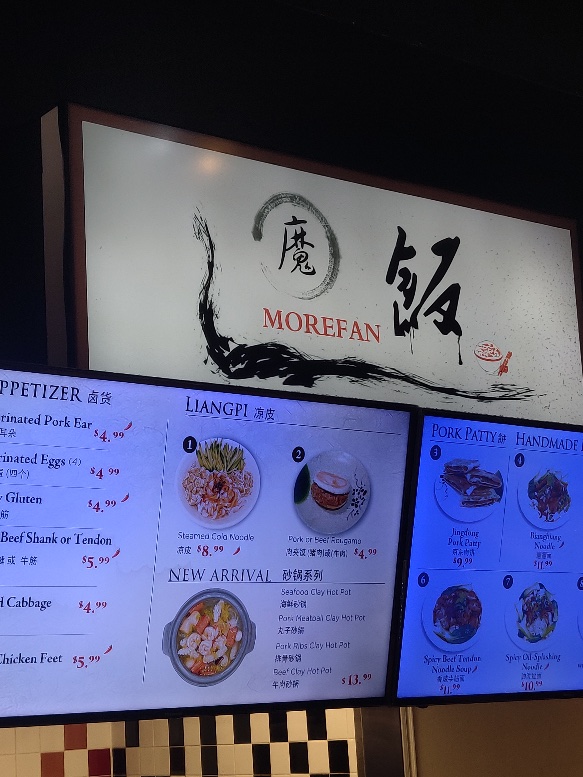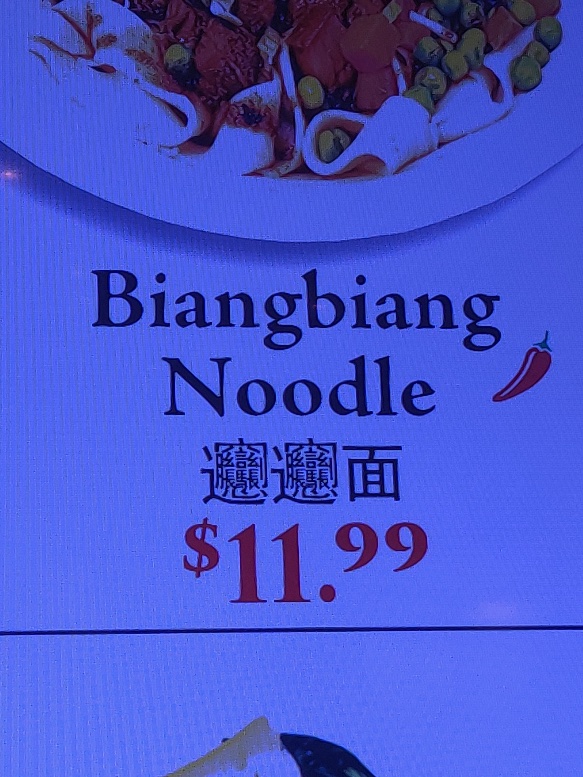Starve Bird
« previous post | next post »
As we were strolling through a mall on the outskirts of Dallas, this sign caught my son's attention:
Since we were quite hungry at that moment, we decided to go inside. Before I describe what we found there, a word of explanation concerning "Starve Bird". This is a take-out app, similar to DoorDash or Grubhub, for humans (not avians) who are hungry / ravenous / starving.
È niǎo wàimài
饿鸟外卖
"Hungry Bird Takeout / Takeaway"
How did we end up there?
Dallas (actually in the suburban city of Plano) has a gigantic Chinese grocery store called Jusgo Supermarket). On either side of Jusgo there are East Asian and Southeast Asian restaurants, and at one end (to the right of the main entrance), there is a food court with numerous small stands: Korean, Shanghainese, Taiwanese, Singaporean, Japanese, Vietnamese, Hakka…. I would probably have eaten at the Hakka place, because the only other time I've had Hakka cuisine (about half a dozen years ago in Taiwan), I really liked it, but it was closed the day we went to the food court (the day after Christmas).
The food at all the other stalls looked delicious too, so I just couldn't decide where to order. After slowly circling around the food court a couple of times, reading the offerings on the signboards hanging above their entrances, I came upon this intriguing stall:
I thought that the name of the shop was quite clever, like it's telling you to eat more rice / food (fàn 飯), while punning on mófàn 魔飯 ("demon rice"), where the mó 魔 is short for móguǐ 魔鬼 ("daemon; demon; devil; ghost; monster"). Scrutinizing the name more carefully, I suspected that the mó 魔 part is actually short for móshù 魔術 ("magic"), hence "magic food", which I verified with the shop owner.
This may only work for me, but I feel a tertiary punning with "mófàn 模范" ("model; example; exemplar; paragon; paradigm; pattern; norm").
The name of the shop having attracted my attention, I began to examine the dishes that they offered, whereupon I almost flipped out. We had happened upon a Xi'an restaurant! Wow! Right away my mouth started to water and my digestive juices began to flow. We at Language Log are quite familiar with Xi'an cooking, not least because of its pièce de résistance, biangbiang noodles!
If you look at item #4 under the MOREFAN shop sign, you will find it. Look for it yourself first, before you examine this closeup:
TK (my son) kept exclaiming, "Wah, wah, wah! That strange character looks like it has a dozen other characters all scrunched together inside it!"
Indeed, that monstrosity (a real móguǐ 魔鬼) of a character has around 60 strokes, depending upon how you write it and who does the counting. Since I have already written a number of posts about it and the food it signifies, I will here and now only say in brief that:
1. it signifies a kind of wide and thick (like a belt) noodle typical of Shaanxi cuisine
2. its name is onomatopoeic, supposedly derived from the sound of slapping the elongating strand of dough on a work surface
3. it has a delectable al dente chewiness
4. it is seasoned to perfection with spices (chilli, garlic, Sichuan pepper, etc.) that are not too hot or numbing, but stimulating and tangy enough to tingle your palate
5. the constituent components of the character have different meanings for different folks; for me, the parts that stand out most are "long" and "horse", but there are many other elements
If you want to know more about the noodles, the character used to write their name, and the other items on the menu, see the posts listed below.
A final note on the availability of biangbiang noodles outside of Xi'an (I'm not sure how they are faring in China, but they used to be rare to nonexistent in the West): recently (I don't know what to attribute the florescence to, restaurants and shops serving biangbiang noodles have begun to proliferate in America. I'm going to Seattle tomorrow, and I will be sure to introduce my family and friends in northwest USA to this toothsome treat from northwest China.
Selected readings
- "Biangbiang: authentic Xi'an grub in the heart of Philadelphia's University City" (6/9/22)
- "A Chinese character that is harder to write than 'biang'" (7/30/20)
- "Murgers and biangbiang in London" (8/17/19)
- "Stroke order" (10/30/18)
- "Writing Chinese characters as a form of punishment" (11/1/15)
- "The Awful Chinese Writing System" (Lingua Franca, 1/20/16)
- Wikipedia article on 'biang'"
- "Peace and Harmony" (10/16/10)
- "Wawa" (12/8/22)
[Thanks to Thomas K. Mair]



Y said,
December 29, 2022 @ 1:34 am
How did the waiter abbreviate biangbiang on their notepad (if they were using one)?
Victor Mair said,
December 29, 2022 @ 11:30 am
@Y
Great question! I'm not sure how she wrote it on her notepad, but I'm absolutely certain that she did not write a hundred and twenty plus strokes.
She took the order very quickly, so it was probably something like "bb", as we know from previous LL posts on restaurant shorthand.
William said,
December 30, 2022 @ 9:16 am
Biang biang are readily available all across Xi'an. I'm not sure about other places in China. I was there several years ago and had them very often. I also impressed my Chinese students at the university with my ability to write, with absolutely horrible penmanship, the Chinese character. They couldn't believe that I had memorized it, although that only takes maybe 10 seconds or 20 seconds for somebody already familiar with the constituent parts of Chinese hanzi.
Jonathan Smith said,
December 30, 2022 @ 6:33 pm
I like thinking of this character as a Poe's law / Tyson zone-type test inspired by Xu Bing's Tian shu or some such, viz. "how risably complex of a 'Chinese character' could we invent and have people still take it seriously?" Conclusion >> no limit :D